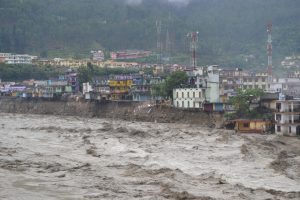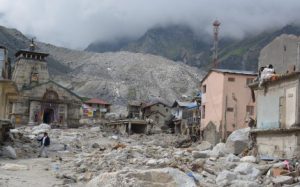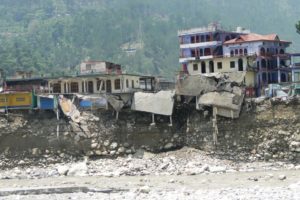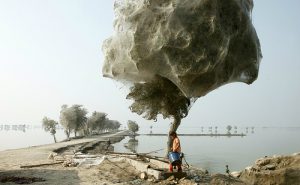India is still grappling with the effects of the flash floods that have destroyed a significant part of the Himalayas. Eleven days later, with the official death toll crossing 800 – the unofficial is in many thousands – the focus remains on rescuing people stranded by landslides. Military and paramilitary forces – aided by volunteers – continue a heroic effort. They have already got around 100,000 people to safe places, and have to rescue over 30,000 more.
In all this, there is little talk of why the disaster became so huge. Politicians insist this is not the time to talk about it. But in the absence of a discussion, the policies that magnified the disaster impact are likely to be repeated.
There are two parts to the why question – why did the flash floods become so big, and why did the damage become so extensive? The answer to the first question, at least in part, is that the Chorabari Taal (lake) – at one of the snouts of the Chorabari glacier and just above the famous Kedarnath temple – burst its banks.
Chorabari glacier lake outburst magnifies floods
The seven-kilometre-long Chorabari glacier starts at an altitude of approximately 6,000 metres at the slopes of Kedarnath peak, just to the west of the Kedarnath Wildlife Sanctuary (see map).
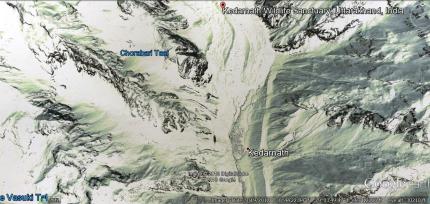
R.K. Chaujar of the Dehradun-based Wadia Institute of Himalayan Geology has said that originally a single glacier covered the area. Like almost all glaciers in the Himalayas, it has receded due to climate change. The glacier has two snouts. One snout is the source of the MandakiniRiver, one of the major sources of the Ganga. The other snout drains into the Chorabari lake.
The lake – officially called Gandhi Sarovar, though few use that name – has been increasing in size as the glacier melts faster due to climate change. This has been corroborated by many visitors to the area, though the change in size has not been measured with any consistency.
Gopal Singh Rawat, senior scientist at the Kathmandu-based International Centre for Integrated Mountain Development (ICIMOD), said, “A phenomenon called the glacial lake outburst flood (GLOF) is responsible for this (the flash flood at Kedarnath and downstream). The Kedarnath valley is situated right under the glacial lake… Due to the heavy downpour, the lake burst and water flowed into the valley, taking all the sediment with it, thereby making it deadlier. GLOF is a relatively new phenomenon in the Himalaya. It is happening due to global warming which is leading to melting glaciers. This means more and more glacial lakes will be formed in the coming times, leading to potential disasters.”
Due to landslides in the affected areas, rescue teams or scientists have not yet been able to reach this lake or any of the other lakes at glacier snouts. Looking at satellite images, the scientists are sure that the Chorabari lake burst. They are not so sure of lakes at the heads of valleys where other flash floods started. But clearly, GLOF is now a major effect of climate change that has come to India, after hitting Bhutan and Nepal.
So the flash floods were magnified by at least one bursting lake. And of course the flash floods would have occurred anyway, since it rained 240 mm in a 24-hour period starting June 15, more than ten times the usual amount on a rainy day.
Ill-planned construction and illegal mining
But how did the floods cause so much havoc, and why have landslides hit almost all roads in the region? The answer lies in ill-planned or unplanned development, specifically in three areas – road construction, building construction and mining in the riverbeds.
India’s National Mission for Sustaining the Himalayan Ecosystem – one of eight missions under the National Action Plan on Climate Change – has detailed guidelines on how a road should be built in mountain areas. The guidelines talk about the need to have enough culverts so that water flowing down the hill slopes can go under the road; they talk of the importance of removing rubble after construction, and so on. But ask any official in any of the state governments in the Himalayas, and you will find they are ignorant of the guidelines.
The result is that every time a road is built, it disrupts the natural flow of water down the slopes. So the water accumulates under the soil, weakening it. And then, when it rains heavily or there is a flash flood, the water has nowhere to go except to bring down all the mud and the rubble in a landslide and break the road down.
Where roads are made, buildings follow, and they exacerbate the problem. The traditional settlement pattern in the Himalayas is to have homes at or near the top of the slopes, while the farmland stretches below to the valley bottom. This has now been completely disrupted, with buildings hugging the roadsides at the bottom of the valley, and even on the riverbed. Not only are these buildings more vulnerable during a flood, they add to the disruption of natural water channels and thus to the risk of landslides.
The material to construct these buildings – sand and gravel – is mined from the riverbed and from forest areas, both legally and illegally. It is a practice so widespread in Uttarakhand that in the middle of 2011 a Hindu monk went on hunger strike against it. He died under mysterious circumstances, and there was much hue and cry. But the practice continues, with the result that when there is a flood, there is no check on the huge boulders rolling down the riverbeds and causing havoc along the banks.
The state government’s own data shows that 1,608 hectares on the riverbeds were being mined in 2012. The state’s forest department says that between 2000 and 2010, almost 4,000 hectares of land previously under its jurisdiction were diverted for mining.
And on top of this ill-planned development, there are the highly contentious hydropower projects all over the Himalayas, including this region– some operating, some being built, and as many as 65 more in the pipeline in Uttarakhand alone. Now some of the smaller projects being built have been washed away, while power generation and construction work have stopped everywhere.
Perilous pilgrims
The Himalayas are considered holy in much of Asia, and Uttarakhand especially is known as the abode of the gods. Kedarnath, Badrinath, the snouts of the Gangotri and Yamunotri glaciers – from which India’s two longest rivers spring – and Hemkund Sahib are pilgrimage spots visited by thousands every day. On paper there is a limit on the number of pilgrims allowed on this route every year. But policymakers do not find it politically feasible to implement the rules.
Uttarakhand’s tourism department says 28 million tourists and pilgrims visited the state in 2012, double the local population. And once the tourists and pilgrims are there, they need roads, hotels and all associated infrastructure.
One of India’s most respected academics, K.S. Valdiya of the Bangalore-based Jawaharlal Nehru Centre for Advanced Scientific Research, says, “Any human tampering — building roads, constructing hotels on banks and so on — is bound to harm the already fragile landscape. Making and executing laws regarding human activity keeping this factor in mind is the only way to avoid a disaster like the one in Uttarakhand.”
Himanshu Thakkar of the South Asia Network of Dams, Rivers and People says, “Clearly, the need is to do things differently. The region needs development – people who live there need basic amenities like roads, electricity, healthcare and education. They need employment and livelihood options. But equally development cannot come at the cost of the environment, particularly not in the Himalayas. What we need is a new way – the Himalayan way of economic growth that is sustainable. Without this, there can be no future for the region or its people.”
![<p>Kedarnath in the Himalayas after climate change induced landslides in 2013 [Image by Sanjay Semwa]</p>](https://dialogue.earth/content/uploads/2017/04/Kedarnath-shrine-floods-_0.jpg)

